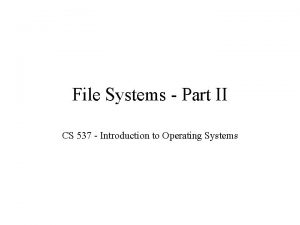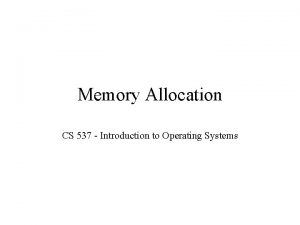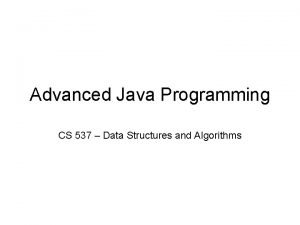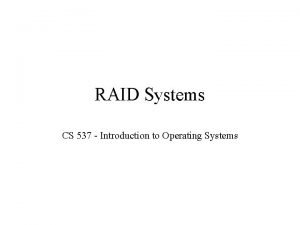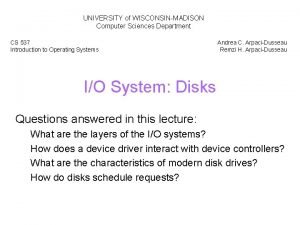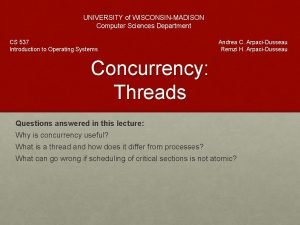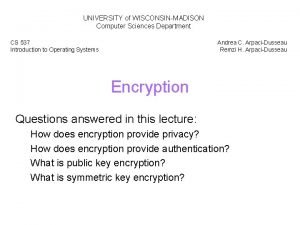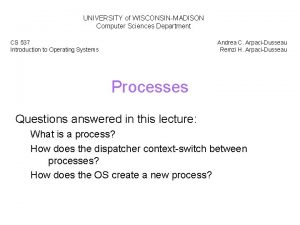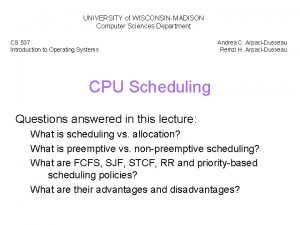UNIVERSITY of WISCONSINMADISON Computer Sciences Department CS 537













- Slides: 13

UNIVERSITY of WISCONSIN-MADISON Computer Sciences Department CS 537 Introduction to Operating Systems Andrea C. Arpaci-Dusseau Remzi H. Arpaci-Dusseau Distributed File Systems Questions answered in this lecture: Why are distributed file systems useful? What is difficult about distributed file systems? How does NFS work?

What is a distributed file system? Client Server Client Network Client Examples: NFS, AFS

Motivation Why are distributed file systems useful? • Access from multiple clients – Same user on different machines can access same files • Simplifies sharing – Different users on different machines can read/write to same files • Simplifies administration – One shared server to maintain (and backup) • Improve reliability – Add RAID storage to server

Challenges Transparent access • User sees single, global file system regardless of location Scalable performance • Performance does not degrade as more clients are added Fault Tolerance • Client and server identify and respond appropriately when other crashes Consistency • See same directory and file contents on different clients at same time Security • Secure communication and user authentication Tension across these goals • Example: Caching helps performance, but hurts consistency

Case Study: NFS Sun’s Network File System • Introduced in 1980 s, multiple versions (v 2, v 3, v 4) Key idea #1: Stateless server • Server not required to remember anything (in memory) – Which clients are connected, which files are open, . . . • Implication: All client requests have enough info to complete op – Example: Client specifies offset in file to write to • One Advantage: Server state does not grow with more clients Key idea #2: Idempotent server operations • Operation can be repeated with same result (no side effects) • Example: a=b+1; Not a=a+1; Helps which Challenge? ?

NFS Overview Remote Procedure Calls (RPC) for communication between client and server Client Implementation • Provides transparent access to NFS file system – UNIX contains Virtual File system layer (VFS) – Vnode: interface for procedures on an individual file • Translates vnode operations to NFS RPCs Server Implementation • Stateless: Must not have anything only in memory • Implication: All modified data written to stable storage before return control to client – Servers often add NVRAM to improve performance

Basic NFS Protocol Operations • lookup(dirfh, name) returns (fh, attributes) – Use mount protocol for root directory • • • create(dirfh, name, attr) returns (newfs, attr) remove(dirfs, name) returns (status) read(fh, offset, count) returns (attr, data) write(fh, offset, count, data) returns attr gettattr(fh) returns attr What is missing? ?

Mapping UNIX System Calls to NFS Operations Unix system call: fd = open(“/dir/foo”) • Traverse pathname to get filehandle for foo – dirfh = lookup(rootdirfh, “dir”); – fh = lookup(dirfh, “foo”); • Record mapping from fd file descriptor to fh NFS filehandle • Set initial file offset to 0 for fd • Return fd file descriptor Unix system call: read(fd, buffer, bytes) • • Get current file offset for fd Map fd to fh NFS filehandle Call data = read(fh, offset, bytes) and copy data into buffer Increment file offset by bytes Unix system call: close(fd) • Free resources assocatiated with fd

Client-side Caching needed to improve performance • Reads: Check local cache before going to server • Writes: Only periodically write-back data to server • Avoid contacting server – Avoid slow communication over network – Server becomes scalability bottleneck with more clients Two client caches • data blocks • attributes (metadata)

Cache Consistency Problem: Consistency across multiple copies (server and multiple clients) • How to keep data consistent between client and server? – If file is changed on server, will client see update? – Determining factor: Read policy on clients • How to keep data consistent across clients? – If write file on client A and read on client B, will B see update? – Determining factor: Write and read policy on clients

NFS Consistency: Reads: How does client keep current with server state? • Attribute cache: Used to determine when file changes – File open: Client checks server to see if attributes have changed • If haven’t checked in past T seconds (configurable, T=3) – Discard entries every N seconds (configurable, N=60) • Data cache – Discard all blocks of file if attributes show file has been modified Eg: Client cache has file A’s attributes and blocks 1, 2, 3 • • • Client opens A: Client reads block 1 Client waits 70 seconds Client reads block 2 Block 3 is changed on server Client reads block 3 Client reads block 4 Client waits 70 seconds Client reads block 1

NFS Consistency: Writes: How does client update server? • Files – Write-back from client cache to server every 30 seconds – Also, Flush on close() • Directories – Synchronously write to server Example: Client X and Y have file A (blocks 1, 2, 3) cached • • Clients X and Y open file A Client X writes to blocks 1 and 2 Client Y reads block 1 30 seconds later. . . Client Y reads block 2 40 seconds later. . . Client Y reads block 1

Conclusions Distributed file systems • Important for data sharing • Challenges: Fault tolerance, scalable performance, and consistency NFS: Popular distributed file system • Key features: – Stateless server, idempotent operations: Simplifies fault tolerance – Crashed server appears as slow server to clients • Client caches needed for scalable performance – Rules for invalidating cache entries and flushing data to server are not straight-forward – Data consistency very hard to reason about



